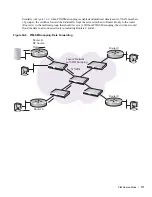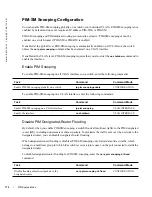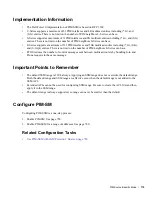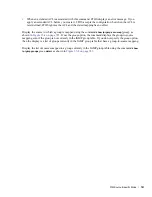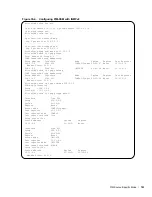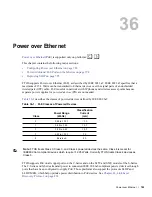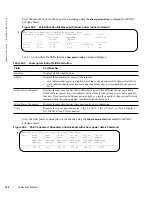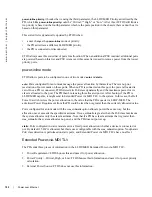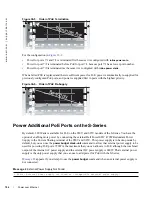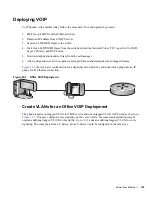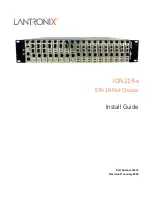
Power over Ethernet |
785
36
Power over Ethernet
Power over Ethernet
(PoE) is supported only on platforms:
c s
This chapter contains the following major sections:
•
Configuring Power over Ethernet on page 786
•
Power Additional PoE Ports on the S-Series on page 794
•
Deploying VOIP on page 795
FTOS supports Power over Ethernet (PoE), as described by IEEE 802.3af . IEEE 802.3af specifies that a
maximum of 15.4 Watts can be transmitted to Ethernet devices over the signal pairs of an unshielded
twisted pair (UTP) cable. PoE is useful in networks with IP phones and wireless access points because
separate power supplies for
powered devices
(PD) are not needed.
Table 36-2
describes the classes of powered devices defined by IEEE 802.3af:
FTOS supports PoE on all copper ports on the C-Series and on the S25V and S50V models of the S-Series.
The C-Series and S-Series transmit power to connected IEEE 802.3af-compliant powered devices through
ports that have been configured to supply PoE. Those platforms also support the protocols LLDP and
LLDP-MED, which help optimize power distribution to PoE devices. See
Chapter 46, Link Layer
Discovery Protocol, on page 861
.
Table 36-1. PoE Classes of Powered Devices
Class
Power Range
(Watts)
Classification
Current
(mA)
0
0.44 to 12.95
< 5.0
1
0.44 to 3.84
10.5
2
3.84 to 6.49
18.5
3
6.49 to 12.95
28
4
Reserved
40
Note:
FTOS treats Class 0, Class 3, and Class 4 powered devices the same. Class 4 is meant for
IEEE802.3at compliant devices which require >12.95 Watts. Currently FTOS treats Class 4 devices as
Class 3.
Summary of Contents for Force10 E300
Page 1: ...FTOS Configuration Guide FTOS 8 4 2 7 E Series TeraScale C Series S Series S50 S25 ...
Page 32: ...32 w w w d e l l c o m s u p p o r t d e l l c o m ...
Page 132: ...132 802 1X w w w d e l l c o m s u p p o r t d e l l c o m ...
Page 310: ...310 Configuration Replace and Rollback w w w d e l l c o m s u p p o r t d e l l c o m ...
Page 330: ...330 Dynamic Host Configuration Protocol w w w d e l l c o m s u p p o r t d e l l c o m ...
Page 402: ...402 High Availability w w w d e l l c o m s u p p o r t d e l l c o m ...
Page 462: ...462 Interfaces w w w d e l l c o m s u p p o r t d e l l c o m ...
Page 482: ...482 IPv4 Addressing w w w d e l l c o m s u p p o r t d e l l c o m ...
Page 506: ...506 IPv6 Addressing w w w d e l l c o m s u p p o r t d e l l c o m ...
Page 582: ...582 Layer 2 w w w d e l l c o m s u p p o r t d e l l c o m ...
Page 642: ...642 Multicast Source Discovery Protocol w w w d e l l c o m s u p p o r t d e l l c o m ...
Page 662: ...662 Multiple Spanning Tree Protocol w w w d e l l c o m s u p p o r t d e l l c o m ...
Page 690: ...690 Object Tracking w w w d e l l c o m s u p p o r t d e l l c o m ...
Page 754: ...754 PIM Dense Mode w w w d e l l c o m s u p p o r t d e l l c o m ...
Page 784: ...784 PIM Source Specific Mode w w w d e l l c o m s u p p o r t d e l l c o m ...
Page 800: ...800 Power over Ethernet w w w d e l l c o m s u p p o r t d e l l c o m ...
Page 876: ...876 Quality of Service w w w d e l l c o m s u p p o r t d e l l c o m ...
Page 892: ...892 Routing Information Protocol w w w d e l l c o m s u p p o r t d e l l c o m ...
Page 1006: ...1006 Simple Network Management Protocol w w w d e l l c o m s u p p o r t d e l l c o m ...
Page 1018: ...1018 SONET SDH w w w d e l l c o m s u p p o r t d e l l c o m ...
Page 1048: ...1048 Broadcast Storm Control w w w d e l l c o m s u p p o r t d e l l c o m ...
Page 1096: ...1096 Uplink Failure Detection UFD w w w d e l l c o m s u p p o r t d e l l c o m ...
Page 1098: ...1098 Upgrade Procedures w w w d e l l c o m s u p p o r t d e l l c o m ...
Page 1196: ...1196 C Series Debugging and Diagnostics w w w d e l l c o m s u p p o r t d e l l c o m ...
Page 1252: ...1252 Standards Compliance w w w d e l l c o m s u p p o r t d e l l c o m ...
Page 1262: ...1262 Index w w w d e l l c o m s u p p o r t d e l l c o m ...

